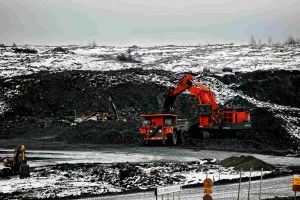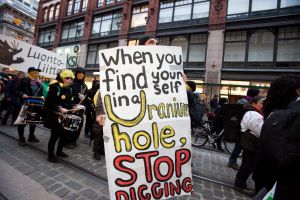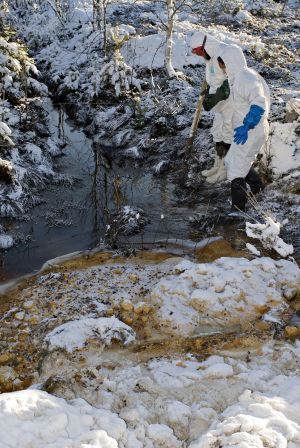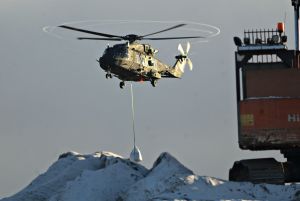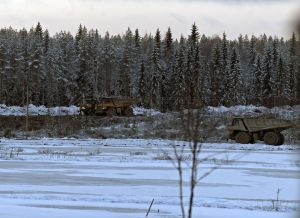Difference between revisions of "Talvivaara mine: environmental disaster in Finland"
(updated) |
(updated) |
||
| Line 22: | Line 22: | ||
For several days the Talvivaara company was not able to locate the site of the leak<ref>http://yle.fi/uutiset/talvivaara_struggles_to_find_leak/6366349 as at November 12, 2012</ref>. Since the beginning of the catastrophe, the mine has discharged hundreds of thousands of cubic metres of toxic effluent into the nearby environment<ref name="sll">http://www.sll.fi/ajankohtaista/tiedotteet/2012/concern-over-toxic-leak-from-europe2019s-largest-nickel-mine-in-north-eastern-finland as at November 12, 2012</ref>. According to a local newspaper some 4,000 cubic metres of waste water escaped the Talvivaara mine per hour<ref>http://www.stoptalvivaara.org/fi/waste-towards-savolax.html as at November 12, 2012</ref>. Greenpeace called it "Finland's biggest chemical catastrophe in history"<ref name="greenpeace" />. | For several days the Talvivaara company was not able to locate the site of the leak<ref>http://yle.fi/uutiset/talvivaara_struggles_to_find_leak/6366349 as at November 12, 2012</ref>. Since the beginning of the catastrophe, the mine has discharged hundreds of thousands of cubic metres of toxic effluent into the nearby environment<ref name="sll">http://www.sll.fi/ajankohtaista/tiedotteet/2012/concern-over-toxic-leak-from-europe2019s-largest-nickel-mine-in-north-eastern-finland as at November 12, 2012</ref>. According to a local newspaper some 4,000 cubic metres of waste water escaped the Talvivaara mine per hour<ref>http://www.stoptalvivaara.org/fi/waste-towards-savolax.html as at November 12, 2012</ref>. Greenpeace called it "Finland's biggest chemical catastrophe in history"<ref name="greenpeace" />. | ||
| − | The mine has leaked heavy metals like cadmium and nickel into its surroundings and nearby lakes. The uranium concentration in the effluent has risen by 100-200 times its normal level in the bottom and surface waters.<ref name="sll" /> | + | The mine has leaked heavy metals like cadmium and nickel into its surroundings and nearby lakes. The uranium concentration in the effluent has risen by 100-200 times its normal level in the bottom and surface waters.<ref name="sll" /> Military and civil helicopters were in operation to plug the leaks in the waste water dam. "Helicopters are used to dump neutralizing calcium into the waste water, as well as moving concrete and patching material to leakages" explained the news company YLE<ref>http://yle.fi/uutiset/talvivaara_waste_water_pond_still_leaking/6371489 as at November 12, 2012</ref>. |
Revision as of 19:25, 17 November 2012
Since the November 4, 2012[1] a cocktail of poisonous chemicals leaked from the Talvivaara mine in Eastern Finland to the surrounding rivers and lakes. An investigation of the Finnish Environment Institute found high levels of aluminium, cadmium, nickel, uranium and zinc in the released waste waters. In a big demonstration about 1,000 people demanded to close the mine. A petition with some 17,000 signatures was handed over to the Minister of Environment.[2]
Only during the first day of the desaster, over 220,000 cubic metres of waste water have leaked from a gypsum waste pond at the Talvivaara mine in Kainuu. Some of the water has spilled to an area outside the mine.[3] Since that day the leakage continued for at least ten days. The operator of the mine tried for weeks to close the leak[4]. On November 8 they announced to have blocked a leak at its gypsum pond. Only half a day later a new leakage was reported. It is estimated that over 10,000 kilos of nickel and unknown amounts of uranium escaped the mine.[4]
According to the Kainuu Employment and Economic Development Centre the gypsum pond was not supposed to be used for storing waste waters, and that there had not been any special permit for that. On November 8, Minister of Environment Ville Niinistö called the leak a "serious environmental crime".[4] Since years local people had accused Talvivaara to have extracted hundreds of tons of uranium a year without permission.[5]
For several days the Talvivaara company was not able to locate the site of the leak[6]. Since the beginning of the catastrophe, the mine has discharged hundreds of thousands of cubic metres of toxic effluent into the nearby environment[7]. According to a local newspaper some 4,000 cubic metres of waste water escaped the Talvivaara mine per hour[8]. Greenpeace called it "Finland's biggest chemical catastrophe in history"[1].
The mine has leaked heavy metals like cadmium and nickel into its surroundings and nearby lakes. The uranium concentration in the effluent has risen by 100-200 times its normal level in the bottom and surface waters.[7] Military and civil helicopters were in operation to plug the leaks in the waste water dam. "Helicopters are used to dump neutralizing calcium into the waste water, as well as moving concrete and patching material to leakages" explained the news company YLE[9].
Material:
- Talvivaara leak newsstream
- video of the rally in Helsinki on November 14 Finnish
- photos of the rally in Helsinki (free to use, source must be mentioned)
- ↑ 1.0 1.1 http://www.greenpeace.org/international/en/news/Blogs/makingwaves/chemical-spill-finland/blog/42935/ as at November 12, 2012
- ↑ http://yle.fi/uutiset/stop_talvivaara_protest_brings_carnival_mood_to_helsinki/6376956 as at November 17, 2012
- ↑ http://yle.fi/uutiset/talvivaara_waste_water_leaks_into_environment/6363459 as at November 12, 2012
- ↑ 4.0 4.1 4.2 http://yle.fi/uutiset/talvivaara_waste_water_leak_plugged/6369461 as at November 12, 2012
- ↑ http://www.stoptalvivaara.org/fi/newsstream.html as at November 12, 2012
- ↑ http://yle.fi/uutiset/talvivaara_struggles_to_find_leak/6366349 as at November 12, 2012
- ↑ 7.0 7.1 http://www.sll.fi/ajankohtaista/tiedotteet/2012/concern-over-toxic-leak-from-europe2019s-largest-nickel-mine-in-north-eastern-finland as at November 12, 2012
- ↑ http://www.stoptalvivaara.org/fi/waste-towards-savolax.html as at November 12, 2012
- ↑ http://yle.fi/uutiset/talvivaara_waste_water_pond_still_leaking/6371489 as at November 12, 2012
